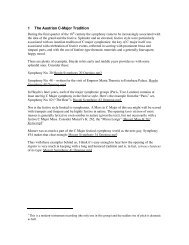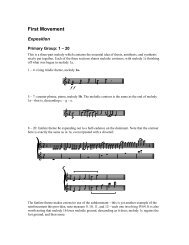Mozart Symphony No. 39 (PDF) - Scott Foglesong
Mozart Symphony No. 39 (PDF) - Scott Foglesong
Mozart Symphony No. 39 (PDF) - Scott Foglesong
You also want an ePaper? Increase the reach of your titles
YUMPU automatically turns print PDFs into web optimized ePapers that Google loves.
& 4<br />
2 bbb ú<br />
& 4<br />
2 bbb ä Ï Ï Ï<br />
Which contains the seed of a critically important two-note motive which will be significantly<br />
featured in the development section (Bob Greenberg describes it as a ‘near-death’ experience):<br />
& 4<br />
2<br />
4<br />
2<br />
bbb ú<br />
ú ú<br />
ú<br />
&bbb ú ú<br />
That four-note idea also serves as the structure for the second theme as well:<br />
&b c b b Ï Ï Ï Ï Ï Ï Ï Ï<br />
&b c b b H<br />
h h<br />
This should all be fairly familiar stuff, especially if you’ve had a class on the 5 th symphony.<br />
But it isn’t the only way to do it.<br />
3.2 Linear Development<br />
This is my coinage since I’m not quite sure what the official phrase is—if there is one, which I<br />
rather doubt.<br />
ú<br />
ú<br />
The idea here is that a theme does not develop from an original seed as in the above, but rather<br />
breaks off pieces of itself, which then develop into new themes. This can be thought of as the way<br />
that certain creatures can develop, like flatworms, which can be cut in two and then will<br />
regenerate the rest of the body and then you get two flatworms where previously you had one.<br />
But unlike the flatworm analogy, the melody actually grows and changes—the part of it that falls<br />
off and grows is something new, still showing its parentage clearly but being something else.<br />
Perhaps this should be called evolutionary development since there’s a feel of that about the<br />
process.<br />
Let’s look at the theme of the first movement of <strong>Symphony</strong> <strong>39</strong>. The main theme has this outline:<br />
4<br />
3<br />
&bbb Î<br />
Ï Ï ú. Ï Ï Ï ú Ï Ï Ï Ï<br />
& 4<br />
3 bbb ú ú ú<br />
ú<br />
ú<br />
h<br />
ú<br />
ú<br />
ú. Ï Ï Ï ú Ï Î Ï Ï<br />
ú Ï<br />
Ï Ï Ï Ï úÏ Ï úÏ Ï úÏ<br />
The outline makes it clear that there is an ‘a’ motive (the descending triad) and a ‘b’ motive (the<br />
descending scalar passage, which is secondary to the triad.<br />
<strong>No</strong>w, the first change which is brought to this particular theme is a clear transformation of ‘a’—in<br />
the ‘motivic’ fashion of development:





